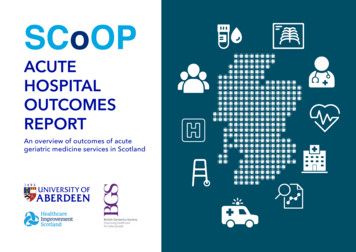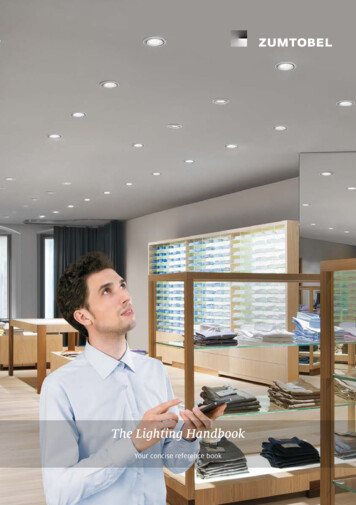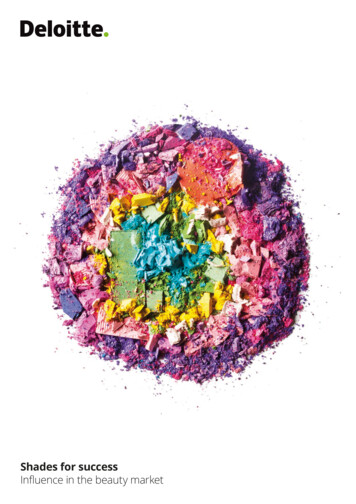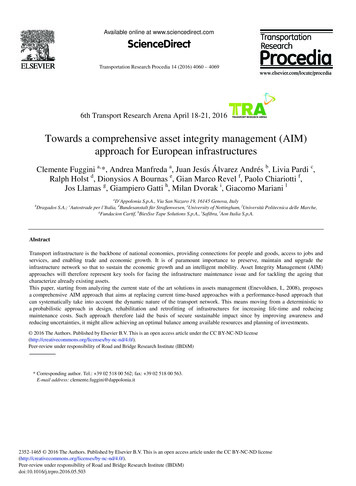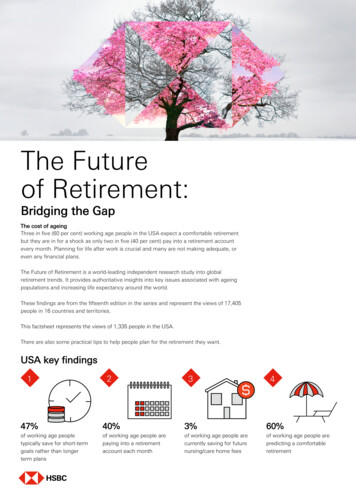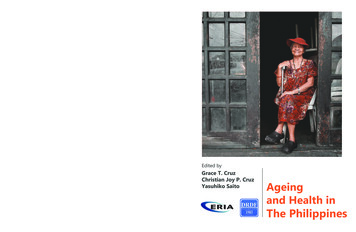
Transcription
The Longitudinal Study on Ageing and Health in the Philippines (LSAHP) is the firstmulti-actor longitudinal study on ageing in the Philippines with information coming from older Filipinos, their caregivers, and adult children. The 2018 baseline dataprovides comprehensive information on the health, economic status, and overallwell-being of a nationally representative sample of older Filipinos aged 60 and older.These data will be a valuable resource for the crafting of evidence-based policiesand programmes for this sector of the population.LSAHP is designed to (1) investigate the health status and well-being, as well as theircorrelates, of Filipinos aged 60 years and over; and (2) assess the determinants ofhealth status and transitions in health status and overall well-being. The study is partof a comparative study of the Philippines and Viet Nam. LSAHP is funded by theEconomic Research Institute for ASEAN and East Asia and implemented by theDemographic Research and Development Foundation, Inc.Headquarters:The ASEAN Secretariat 70A, JalanSisingamangaraja South Jakarta12110, IndonesiaAnnex Office (Mailing Address):Sentral Senayan II, 5th & 6th floorJalan Asia Afrika No. 8 Gelora BungKarno, Senayan Jakarta Pusat 10270,IndonesiaAgeing and Health in the PhilippinesAgeing and Health in The PhilippinesAddress :PH1200 2/F Palma Hall,University of the Philippines,Roxas Ave., Diliman, QuezonCity 1101, PhilippinesEdited byGrace T. CruzChristian Joy P. CruzYasuhiko SaitoWebsite : www.eria.org2019Ageingand Health inThe Philippines
Edited byGrace T. CruzChristian Joy P. CruzYasuhiko SaitoAgeingand Health inThe Philippines
Copyright 2019 by Economic Research Institute for ASEAN and East Asia and Demographic Research andDevelopment Foundation, Inc.Published byEconomic Research Institute for ASEAN and East Asia (ERIA)Sentral Senayan 2, 6th floor,Jalan Asia Afrika no.8Central Jakarta 10270IndonesiaandDemographic Research and Development Foundation, Inc.2/F Palma Hall, University of the PhilippinesDiliman, Quezon CityPhilippinesAll rights reserved. No part of this publication may be reproduced, stored in a retrieval system, or transmittedin any form by any means electronic or mechanical without prior written notice to and permission from thepublishers.Layout by Fadriani Trianingsih and Rachmadea AisyahCover design by Ranti AmeliaISBN: 978-602-54602-2-7Suggested citation:Cruz, G.T., C.J.P. Cruz and Y. Saito (eds.) (2019), Ageing and Health in the Philipines. Jakarta: Economic ResearchInstitute for ASEAN and East Asia (ERIA).
ForewordPopulation ageing can be seen as one of the most outstanding achievements ofhumanity.I am a Japanese person born in the year 1952. The demographic statistics of Japanfrom my birth year to the present are indicative of the substantial trends in populationageing.According to statistics from the Government of Japan, the fertility rate in 1952 was ashigh as 2.98 per woman. This means that more than two million babies were born inJapan as my contemporaries. The under-five mortality rate of the same year was highat 79 per 1,000 live births, with a male life expectancy of 61.9 years.By 2017, a mere 65 years from my birth year, the fertility rate in Japan had dropped byhalf to 1.43 per woman, which translates into only about 0.94 million births. Moreover,the under-five mortality rate had fallen drastically to as low as 2.6 per 1,000 live births,and the average male life expectancy had increased to 81.1 years. As a result of thisdemographic transition, the proportion of the people of 60 years of age or older was ashigh as 34% as of 1 October 2017.Japan is an extreme example of population ageing, a trend that is also occurringworldwide. This demographic trend is a consequence of improvements in public healthand progress achieved in medical science, a field in which humanity has taken greatstrides especially over the last one hundred years. Until a couple of centuries ago, welost approximately one in four babies before their fifth birthdays. Population ageing hasresulted in fundamental changes to our social system.The international community has identified population ageing as a critical issue and,as a result, has taken several actions to cope with this social change. The MadridInternational Plan of Action on Ageing was adopted in 2002 at the Second WorldAssembly on Ageing and called for ‘changes in attitudes, policies and practices’ to fulfil‘the enormous potential of ageing’.Statistics show that Asia has the most notable and rapid pace of population ageing,both in terms of the numbers of older people and the older population’s share ofiii
the total population. This is also projected to become the case for ASEAN MemberStates. In 2015, the Heads of State/Government of ASEAN Member States adoptedthe Kuala Lumpur Declaration on Ageing: Empowering Older Persons in ASEAN,recognising that ‘the promotion of health, active and productive ageing’ is ‘key tothe well-being of older persons as valuable members of the family, community andsociety’.As an international think tank mandated to provide policy recommendations forASEAN Member States on issues of economic integration, narrowing developmentgaps, and sustainable development, the Economic Research Institute for ASEAN andEast Asia (ERIA) has a responsibility to assist ASEAN Member States in fulfilling thisdeclaration.But ERIA’s mandate is not limited to the three objectives stated above – economicintegration, narrowing development gaps, and sustainable development. Due tothe rapid change of society as a result of the advancement of Information andCommunication Technology (ICT), it is important to promote re-skilling educationfor the existing workforce, particularly for older people, to allow them to catch upand upgrade their skills. Healthy ageing – through the capacity development ofolder people – is of key importance for the improvement of productivity in the era ofpopulation ageing. ERIA is a unique organisation that carries out research not onlyin the field of economics, but also in agricultural and environmental science, andpopulation ageing is another area of research. We would like to integrate the outcomeof our studies on population ageing with industrial policies designed for the era ofdigitalisation.In 2017, ERIA received a contribution from the Government of Japan to promoteresearch and come up with policy recommendations on population ageing and longterm care. This contribution was provided as one of the action items in the contextof the Asia Health and Wellbeing Initiative (AHWIN) launched by the Governmentof Japan in 2016. Taking the concept of AHWIN into account, and making full useof ERIA’s capacity and network in ASEAN Member States, ERIA launched a numberof activities to improve policymaking and thereby contribute to healthy, active, andproductive ageing.To this end, ERIA decided to conduct longitudinal studies targeting older peoplein ASEAN Member States in collaboration with our partner organisations. TheLongitudinal Study of Ageing and Health in the Philippines (LSAHP) is one ofiv
them and this report is the product of the baseline survey of LSAHP. It provides acomprehensive look at the realities faced by older people in the Philippines: fromhealth status to healthcare utilisation, economic wellbeing, and care for the elderly.All information is indispensable for policymaking on healthy and active ageing.This project is designed to become a ‘longitudinal’ study, though at this stage itreports only the initial results of the baseline survey. The next stage of the project,which will be implemented in 2020, is crucial, since it will reveal the true results ofthe longitudinal data – this will allow us to analyse the factors contributing to theimprovement of health expectancy.We owe the achievements of this project to the dedicated work and firm leadershipof Dr. Grace T. Cruz, Chairperson of Demographic Research and DevelopmentFoundation, Inc. and a professor of the University of the Philippines PopulationInstitute. I also wish to praise the staff of DRDF for their outstanding work on theproject from fieldwork to data processing. I heard that some of the field interviewersbecame emotional during the interviews when they learned about the realities theelderly people face on a daily basis. That is an unexpected effect of this project,but I hope such experiences will contribute to an awareness of the issues related topopulation ageing in the country, and lead to the encouragement of communitybased approaches as well as policymaking, which will benefit the older population.Furthermore, I would like to express my gratitude to the members of the LSAHPAdvisory Committee of this study for the valuable advice they provided. This studyis an ongoing project, and your continued and further support would be greatlyappreciated.We must not forget the support of Filipino mothers, fathers, grandmothers, andgrandfathers who were randomly selected as respondents for this study. Theremarkable 94% response rate shows that Filipinos understand the importanceof social surveys. In our study, we also interviewed the children and caregivers ofthe selected respondents. Their kind cooperation enabled us to perform a morecomprehensive analysis of the realities of older people. Dear mums, dads, families,caregivers, and related people, without your continued cooperation, this study wouldnot have been possible. Thank you, and we look forward to seeing you again at thetime of the next survey in 2020.v
Lastly, I would like to reaffirm that population ageing is a mark of the success ofhumanity. I believe the improvement of health expectancy is the most important targetto take advantage of this opportunity. I hope the rich information in this report will befully utilised by all stakeholders – governments, international organisations, academia,civil organisations, the private sector, etc. – for the fulfilment of our ultimate goal:healthy, active, and productive ageing.Thank you.Professor Hidetoshi NishimuraPresident, Economic Research Institute for ASEAN and East Asiavi
Republic of the PhilippinesNational Economic and Development AuthorityMessageThe National Economic and Development Authority (NEDA) extends its warmestcongratulations to the Demographic Research and Development Foundation, Inc.(DRDF) and the Economic Research Institute for the ASEAN and East Asia (ERIA)for successfully conducting the 2018 baseline survey of the Longitudinal Study ofAgeing and Health in the Philippines (LSAHP). This ground-breaking study setsthe stage for the very first longitudinal study on ageing in the Philippines. It is a richsource of information, which will advance the goals of active and healthy ageing in thecountry.LSAHP provides details on the various aspects of ageing as experienced by olderpeople and their immediate kin. This wide range of data – collected from about 6,000older people nationwide, their children, and caregivers – include information on livingconditions, socio-economic status, levels and sources of income, family structures,social networks, and access to government services like social pension. All these arerelevant to the monitoring of the Philippine Sustainable Development Goal (SDGs)commitments for older people.We are confident that the findings of this longitudinal study will help guide futurepolicies, plans, and programmes so that no older Filipino is left behind. In doing so, weremain steadfast in our vision of an inclusive and sustainable development, ensuring a'matatag, maginhawa, at panatag na buhay para sa lahat'.Ernesto M. PerniaSocioeconomic Planning Secretaryvii
Republic of the PhilippinesDepartment of HealthOFFICE OF THE SECRETARYMessageCongratulations to the Demographic Research and Development Foundation, Inc.(DRDF) and the Economic Research Institute for ASEAN and East Asia (ERIA) forundertaking the 2018 Longitudinal Study of Ageing and Health in the Philippines(LSAHP). The LSAHP provides comprehensive and much-needed information onthe current health status of older Filipinos as measured through multiple indicators ofhealth including physical, functional, mental, dental, and other dimensions.The data from LSAHP will be a big boost to the Department of Health’s goal of pushingfor active and healthy ageing in the Philippines as it will provide information not juston the physical aspects of disease but on a comprehensive list of indicators that canprovide a more holistic picture of the status of health of older Filipinos today. Findingsfrom the LSAHP will better inform policies and programmes that will be crafted by theDepartment of Health to promote active and healthy ageing. The study is also the firstto obtain data on long-term care in the country, a topic that will likely become moreprominent in the future when more Filipinos live to advanced old age. The LSAHPfindings shed light not only on the current health status of senior citizens but alsoidentify the gaps in their access to and use of healthcare services and health insurance.We look forward to using the LSAHP study findings to better understand the healthrelated issues that affect the older sector of our population. This first project report,Ageing in the Philippines, along with the future panel data to be collected on the samesample in successive rounds of the LSAHP will provide the types of evidence on ageingand health that will put our country on par with other countries in the region thatconduct longitudinal studies on ageing and, by so doing, obtain a more comprehensiveand more nuanced view of health issues with advancing age.Francisco T. Duque III, MD MscHealth Secretaryviii
ContentsAcknowledgementsxiList of TablesxiiiList of FiguresxviiList of AcronymsxviiiExecutive SummaryChapter 1Backgroundxx1Grace T. CruzChapter 2The 2018 Longitudinal Study of Ageing and Health in thePhilippines13Grace T. Cruz, Yasuhiko Saito, Christian Joy P. Cruz, and MarkRyan B. PaguiriganChapter 3Filipino Older Persons27Christian Joy P. Cruz and Grace T. CruzChapter 4Health Status47Josefina N. NatividadChapter 5Functional Health75Grace T. Cruz and Yasuhiko SaitoChapter 6Healthcare and Healthcare Utilisation89Josefina N. NatividadChapter 7Economic Well-being105Christian Joy P. CruzChapter 8Generativity, Attitudes, and Beliefs117Grace T. Cruz and Maria Karlene Shawn I. CabarabanChapter 9Activities, Social Isolation, and Information Technology129Nimfa B. OgenaChapter 10 Services for the Older Persons149Mark Ryan B. Paguiriganix
Chapter 11Family Support and Intergenerational Exchanges161Maria Paz N. MarquezChapter 12 Caring for Older Persons173Elma P. LagunaChapter 13 Children of Older Persons193Maria Karlene Shawn I. Cabaraban, Mark Ryan B. Paguirigan, andGrace T. CruzChapter 14 Discussion, Conclusions, and Recommendations215Grace T. Cruz, Josefina N. Natividad, and Yasuhiko SaitoAnnex ALSAHP Sampling Design and Weights227Erniel B. Barrios and Maria Paz N. MarquezAnnex BCharacteristics of Filipino Older Persons with ProxyRespondents235Christian Joy P. Cruz and Grace T. CruzxAnnex CResearch Team and Field Personnel242Annex DAdvisory Committee244
AcknowledgementsThis report, Ageing and Health in the Philippines, using the baseline data of the2018 Philippine Longitudinal Study of Aging and Health in the Philippines (LSAHP),provides the latest nationally representative evidence on ageing in the Philippines.The LSAHP, which is part of a two-country study on the Philippines and VietNam, would not have been possible without the funding support of the EconomicResearch Institute for ASEAN and East Asia. We are particularly grateful to Dr.Osuke Komazawa and Mr. Sota Machida for efficiently coordinating the projectfrom its inception to the writing of this report. We also extend our gratitude to theDemographic Research and Development Foundation, Inc., the LSAHP projectimplementer.The project was conceived at an initial meeting with Undersecretary Juan AntonioPerez III, Executive Director of the Commission on Population and Development,and his associate, Ms. Lyra Gay Ellies S. Borja, in November 2017. We owe thema debt of gratitude for enabling this research in the Philippine setting. We are alsoindebted to the following subject matter specialists for providing their expert advice:Dr. Josefina N. Natividad, Dr. Nimfa B. Ogena, Dr. Elma P. Laguna, and Dr. ShelleyAnn Dela Vega. Associate Professor Maria Paz N. Marquez and Dr. Erniel Barrios alsodeserve recognition for their statistical and technical expertise in data processing andsampling design, which was valuable in the completion of this project.We are most grateful to the following members of the LSAHP advisory committeefor their guidance and support at critical points of the project’s implementation: theDepartment of Health, National Economic and Development Authority, Departmentof Social Welfare and Development, Institute on Aging – National Institutes ofHealth, University of the Philippines Population Institute, Commission on Populationand Development, Philippine Statistics Authority, United Nations Population Fund– Philippines, Asian Development Bank, Philippine Health Insurance Corporation,Social Security System, Government Service Insurance System, Coalition of Servicesfor the Elderly, and the University of the Philippines Diliman – Department ofPsychology.xi
We commend the local government units of the LSAHP study areas for their help infacilitating the data collection, particularly in the geographically isolated and hard-toreach barangays. Special credit goes to the Department of Health for providing us withan endorsement that facilitated the entry of our research teams to the study areas. Weare deeply indebted to the data collection team, including the field supervisors andfield interviewers, for their hard work, commitment, and sacrifices in collecting thebaseline data.This report is dedicated to all the LSAHP participants: the Filipino older people, andtheir caregivers and adult children, who gladly shared their time and life stories. Theircontribution is invaluable, and it is our hope that it will be put to good use when theappropriate agencies decide on future policies and programmes that will ensure activeand healthy ageing in the Philippines.xii
List of TablesTable 1.1Countries with longitudinal surveys on ageing: ASEAN, China,India, Japan and Republic of Korea6Table 2.1Number of respondents per questionnaire21Table 3.1Household and Housing Characteristics29Table 3.2Percent Distribution of Older persons by Sex and Age33Table 3.3Sociodemographic Profile of Older Persons by Sex and Age35Table 3.4Living Arrangement and Residential History by Sex and Age37Table 3.5Characteristics of Parents and Siblings by Sex and Age38Table 3.6Characteristics of Spouse by Sex and Age39Table 3.7Children of Older Persons by Sex and Age40Table 3.8Grandchildren of Older Persons by Sex and Age42Table 4.1Self-assessed Health by Sex and Age49Table 4.2Diagnosed Illnesses by Sex and Age50Table 4.3Experience of Heart attack by Sex and Age51Table 4.4Oral Health by Sex and Age53Table 4.5Sleeping Habits by Sex and Age55Table 4.6Experience of Pain by Sex and Age57Table 4.7History of Falls by Sex and Age59Table 4.8Incontinence by Sex and Age61Table 4.9Mean Depressive Scores of Older Filipinos by Sex and Age62Table 4.10Smoking by Sex and Age63Table 4.11Drinking by Sex and Age64Table 4.12Objective Measures of Health by Sex and Age65Table 5.1Activities of Daily Living (ADLs) by Sex and Age79Table 5.2Instrumental Activities of Daily Living (IADLs) by Sex and Age80Table 5.3Washington Group Short Set on Functioning by Sex and Age81Table 5.4Global Activity Limitation Index (GALI) by Sex and Age83Table 5.5Experience of being Bedridden by Sex and Age83xiii
xivTable 5.6Nagi Functioning Measures by Sex and Age84Table 6.1Inpatient Utilisation by Sex and Age90Table 6.2Outpatient Utilisation by Sex and Age92Table 6.3Unmet Need for Healthcare by Sex and Age93Table 6.4Health Insurance Coverage by Sex and Age93Table 6.5Vaccinations by Sex and Age94Table 6.6Level of Use and Source of Medicines and Supplementsby Sex and Age96Table 6.7Person Who Usually Takes Care of Older Person When He/Sheis Sick Since Age 60 by Sex and Age97Table 6.8Long-term Care by Sex and Age98Table 7.1Sources of Income and Median Monthly Income by Sex and Age106Table 7.2Most Important Source of Income by Sex and Age109Table 7.3Assets and Liabilities by Sex and Age110Table 7.4Sufficiency of Household Income by Sex and Age112Table 7.5Self-assessed Economic Wellbeing Whilst Growing Up by Sexand Age113Table 8.1Generativity by Sex and Age120Table 8.2Attitudes and Beliefs by Sex and Age123Table 9.1Activities by Sex and Age130Table 9.2Religious Activities by Sex and Age131Table 9.3Memberships in Organizations by Sex and Age133Table 9.4Loneliness of Older Persons by Sex and Age135Table 9.5Social Isolation from Relatives Not Coresiding with OlderPerson by Sex and Age137Table 9.6Social Isolation from Friends by Sex and Age138Table 9.7Life Satisfaction by Sex and Age141Table 9.8Use of Information Technology by Sex and Age143Table 10.1Awareness and Use of Services by Sex and Age151Table 10.2Attitudes Towards Homes for the Aged by Sex and Age155
Table 11.1Social Contact between Older Persons to Non-co-residentChildren in the Past 12 Months by Sex and Age162Table 11.2Assistance Provided by Older Persons to Co-resident and Nonco-resident Children in the Past 12 Months by Sex and Age163Table 11.3Assistance Received by the Older Persons from Co-resident andnon-co-resident Children in the Past 12 Months by Sex and Age164Table 11.4Exchange of Financial Support Between Older Persons andChildren, by Sex and Age167Table 11.5Attitudes Toward Family Support of Older Personsby Sex and Age168Table 12.1Type of Caregiver by Sex and Age of Older Person174Table 12.2Characteristics of Primary Caregivers of Older Person178Table 12.3Relationship and Living Arrangement of Primary Caregiver toand with Older Person by Sex and Age180Table 12.4Self-Assessed Health of Primary Caregiver of Older Persons bySex and Age181Table 12.5Primary Caregiver's Perception on Older Person's ADLDifficulty by Sex and Age182Table 12.6Primary Caregiver's Perception of the Need for Assistanceof Older Person with ADL Difficulty by Sex and Age of OlderPerson182Table 12.7Assistance Older Persons for Various Activities of Daily Lifeby Sex and Age of Older Person183Table 12.8Difficulty in Caring for Older Person by Sex and Age of OlderPerson184Table 12.9Situation as a Primary Caregiver by Sex and Age of Older Person185Table 12.10 Characteristics of Potential Caregivers by Sex and Age of OlderPerson187Relationship of Potential Caregiver to Older Personby Sex and Age of Older Person188Table 12.11Table 12.12 Self-Assessed Health of Potential Caregivers of Older Personsand their Willingness to Assume the Caregiver Responsibilityby Sex and AgeTable 13.1Characteristics of Children188196xv
xviTable 13.2Relationship to Older Persons by Sex and Age of Older Person198Table 13.3Support Given to Older Persons by Sex and Age of Older Person201Table 13.4Support Received from Older Person by Sex and Age of OlderPerson203Table 13.5Perception of Children on the Health Status of Older Personsby Sex and Age of Older Person206Table 13.6Perception of Children on the Cognitive Decline of OlderPersons by Sex and Age of Older Person207Table 13.7Attitudes and Beliefs of Children by Sex and Age of OlderPerson209Table A.1List of Sample Areas and their Corresponding Number ofSample Barangays and Sample Size228Table B.1Profile of Respondents by Proxy Status and Screening Type(Unweighted Data)237Table B.2Reasons for Having a Proxy (First Screening) by BackgroundCharacteristics (Unweighted Data)239
List of FiguresFigure 2.1.Conceptual Model of Health States and Health TransitionsAccording to the Disablement Process15Figure 2.2.Conceptual Framework for Factors Related to Health Outcome18Figure 2.3.Map of the 2018 Longitudinal Study of Ageing and Health inthe Philppines Sample Area19Figure 2.4.Study sample21Figure 3.1.Status of Ageing: Philippines, Singapore, and Japan, 1950–204528Figure 4.1Mean Number of Natural Teeth by Sex and Age52Figure 4.2Older Persons Often Troubled with Pain, by Sex and Age (%)58Figure 5.1Functional Difficulty of Older Persons by Sex85Figure 5.2Functional Difficulty of Older Persons by Age85Figure 6.1Distribution of Main Caregiver of Older Persons CurrentlyUnder Long-term Care by Age and Sex101Figure 7.1Self-assessed Economic Wellbeing by Sex and Age111Figure 8.1Best Living Arrangement of Older Persons by Sex and Age124Figure 9.1Percent of Older Filipinos Who Said Religion is Very Importantin Their Lives by Sex and Age132Figure 9.2Current Life Satisfaction by Sex and Age141Figure 10.1Use of Privileges by Sex153Figure 10.2 Use of Privileges by Age153Figure 11.1Exchange of Assistance between Older Person and coresidentchildren166Figure 11.2Exchange of Assistance and Social Contact between OlderPerson and Non-co-resident Children166Figure 12.1Percent Distribution of Primary and Potential Caregiversby Sex and Age177Figure 12.2 Relationship of Primary Caregivers to Older Persons, Sex andAgeFigure 13.1Living Arrangement with Older Person by Sex and AgeFigure 13.2 Perception of Children on the Health Status of Older Personby Sex and Age179197205xvii
List of Acronymsxviii4PsPantawid Pamilya Pilipino ProgramADLActivities of Daily LivingASEANAssociation of Southeast Asian NationsBMIBody Mass IndexCAPIComputer-Assisted Personal InterviewsCCTConditional Cash Transfer programmeCES-DCenter for Epidemiological Studies - Depression ScaleCPHCensus of Population and HousingCYSCredited Years of ServiceDOHDepartment of HealthDRDFDemographic Research and Development Foundation, Inc.DSWDDepartment of Social Welfare and DevelopmentERIAEconomic Research Institute for ASEAN and East AsiaEUEuropean UnionGALIGlobal Activity Limitation IndicatorGSISGovernment Service Insurance SystemHLYHealthy Life YearsIADLInstrumental Activities of Daily LivingICFInternational Classification of Functioning, Disability andHealthITInformation TechnologyLGSLoyola Generativity ScaleLGULocal Government UnitLSAHPLongitudinal Study of Ageing in the PhilippinesLSNSLubben Social Network ScaleLTCLong Term CareNGONon-Government OrganisationsOFWOverseas Filipino WorkerOPOlder PersonPESPhilippine Elderly Survey
PhilHealthPhilippine Health Insurance SystemPSAPhilippine Statistics AuthorityPSOAPhilippine Study on AgingPSUPrimary Sampling UnitSDGsSustainable Development GoalsSPMSQShort Portable Mental State QuestionnaireSRHSelf-Rated HealthSSSSocial Security SystemSWDASocial Welfare and Development AgencyTRAINTax Reform for Acceleration and InclusionUNUnited NationsUNDESAUnited Nations, Department of Economic and Social AffairsVATValue-Added TaxWGSSWashington Group Short Set on FunctioningWHOWorld Health Organizationxix
Executive SummaryThe 2018 Longitudinal Study of Ageing and Health in the Philippines (LSAHP) isthe first nationally representative longitudinal study of ageing to be conducted inthe Philippines. It is designed to (1) investigate the health status and well-being,as well as their correlates, of Filipinos aged 60 years and over; and (2) assess thedeterminants of health status and transitions in health status and overall wellbeing. The LSAHP is part of a comparative study of the Philippines and Viet Nam.It is funded by the Economic Research Institute for ASEAN and East Asia andimplemented by the Demographic Research and Development Foundation, Inc.The baseline survey covered 5,985 older persons (OPs), aged 60 years and over,and had a response rate of 94%. The survey employed a multistage samplingdesign, with provinces as the primary sampling units, barangays as the secondarysampling units, and OPs as the ultimate sampling units. The survey was conductedfrom October 2018 to February 2019. Follow-up interviews will be conductedafter 2 years. Computer-assisted personal interviews using tablets were conductedfor the survey.This report provides an updated profile of older Filipinos, focusing on their healthand well-being, as well as on their caregivers and adult children. The analysisfocuses on outcome indicators of various dimensions of health and well-being,categorised by age and sex of OP respondents.Filipino Older PersonsFemale OPs have the numeric advantage, constituting 60% of the total OPpopulation. The mean age is 69 years, with males registering an average of 68 andfemales 70 years. More male OPs are currently married (63%) or living in (6%),whilst most female OPs are widowed (56%). Most older Filipinos attained at mostan elementary education (66%), but the age pattern for those who reached highschool indicates an improving educational profile, from 18% amongst those aged80 to 31% amongst those aged 60–69.The majority (60%) of OPs co-reside with at least one child, and a greatmajority (75%) have been living in their current residence for at least 5 years. Anxx
overwhelming majority (79%), more so amongst males and the older cohort,prefer to live in the countryside.Only 8% of OPs have either a surviving father or mother, and an insignificantproportion (0.4%) have both surviving parents. Nearly all older Filipinos havechildren (95%), with an average of six children ever born. Two in five OPs reportedhaving lost at least one child to death. Five percent of OPs have adopted childrenor stepchildren, each such OP having an average of 2.6 adopted children orstepchildren. Almost all OPs (96%) reported having at least one grandchild. Onaverage, they became grandparents at about 48 years old. About 24% are fully orpartially in charge of the care of any of their grandchildren, significantly more soamongst older females than males (27% vs. 19%).Self-assessed HealthMost older Filipinos have average self-rated health (48%). Overall, females havebetter self-rated health than males, with
Edited by Grace T. Cruz . Christian Joy P. Cruz Yasuhiko Saito. Ageing and Health in . The Philippines. Ageing and Health in the Philippines. 2019. The Longitudinal Study on



